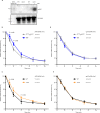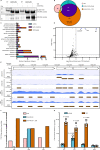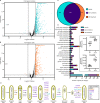An RNA-binding protein acts as a major post-transcriptional modulator in Bacillus anthracis
- PMID: 35314695
- PMCID: PMC8938561
- DOI: 10.1038/s41467-022-29209-4
An RNA-binding protein acts as a major post-transcriptional modulator in Bacillus anthracis
Abstract
HitRS is a two-component system that responds to cell envelope damage in the human pathogen Bacillus anthracis. Here we identify an RNA-binding protein, KrrA, that regulates HitRS function by modulating the stability of the hitRS mRNA. In addition to hitRS, KrrA binds to over 70 RNAs and, directly or indirectly, affects the expression of over 150 genes involved in multiple processes, including genetic competence, sporulation, RNA turnover, DNA repair, transport, and cellular metabolism. KrrA does not exhibit detectable nuclease activity in vitro, and thus the mechanism by which it modulates mRNA stability remains unclear.
© 2022. The Author(s).
Conflict of interest statement
The authors declare no competing interests.
Figures







Similar articles
-
Two-component system cross-regulation integrates Bacillus anthracis response to heme and cell envelope stress.PLoS Pathog. 2014 Mar 27;10(3):e1004044. doi: 10.1371/journal.ppat.1004044. eCollection 2014 Mar. PLoS Pathog. 2014. PMID: 24675902 Free PMC article.
-
DnaJ and ClpX Are Required for HitRS and HssRS Two-Component System Signaling in Bacillus anthracis.Infect Immun. 2022 Jan 25;90(1):e0056021. doi: 10.1128/IAI.00560-21. Epub 2021 Nov 8. Infect Immun. 2022. PMID: 34748369 Free PMC article.
-
Bacillus anthracis Responds to Targocil-Induced Envelope Damage through EdsRS Activation of Cardiolipin Synthesis.mBio. 2020 Mar 31;11(2):e03375-19. doi: 10.1128/mBio.03375-19. mBio. 2020. PMID: 32234818 Free PMC article.
-
AtxA, a Bacillus anthracis global virulence regulator.Res Microbiol. 2010 Nov;161(9):735-42. doi: 10.1016/j.resmic.2010.09.006. Epub 2010 Sep 21. Res Microbiol. 2010. PMID: 20863885 Review.
-
In vivo Bacillus anthracis gene expression requires PagR as an intermediate effector of the AtxA signalling cascade.Int J Med Microbiol. 2004 Apr;293(7-8):619-24. doi: 10.1078/1438-4221-00306. Int J Med Microbiol. 2004. PMID: 15149039 Review.
Cited by
-
One Earth: The Equilibrium between the Human and the Bacterial Worlds.Int J Mol Sci. 2023 Oct 10;24(20):15047. doi: 10.3390/ijms242015047. Int J Mol Sci. 2023. PMID: 37894729 Free PMC article. Review.
References
-
- Inglesby TV, et al. Anthrax as a biological weapon, 2002 updated recommendations for management. J. Am. Med. Assoc. 2002;287:2236–2252. - PubMed
-
- Carlson CJ, et al. The global distribution of Bacillus anthracis and associated anthrax risk to humans, livestock and wildlife. Nat. Microbiol. 2019;4:1337–1343. - PubMed
Publication types
MeSH terms
Substances
Grants and funding
LinkOut - more resources
Full Text Sources
Molecular Biology Databases

